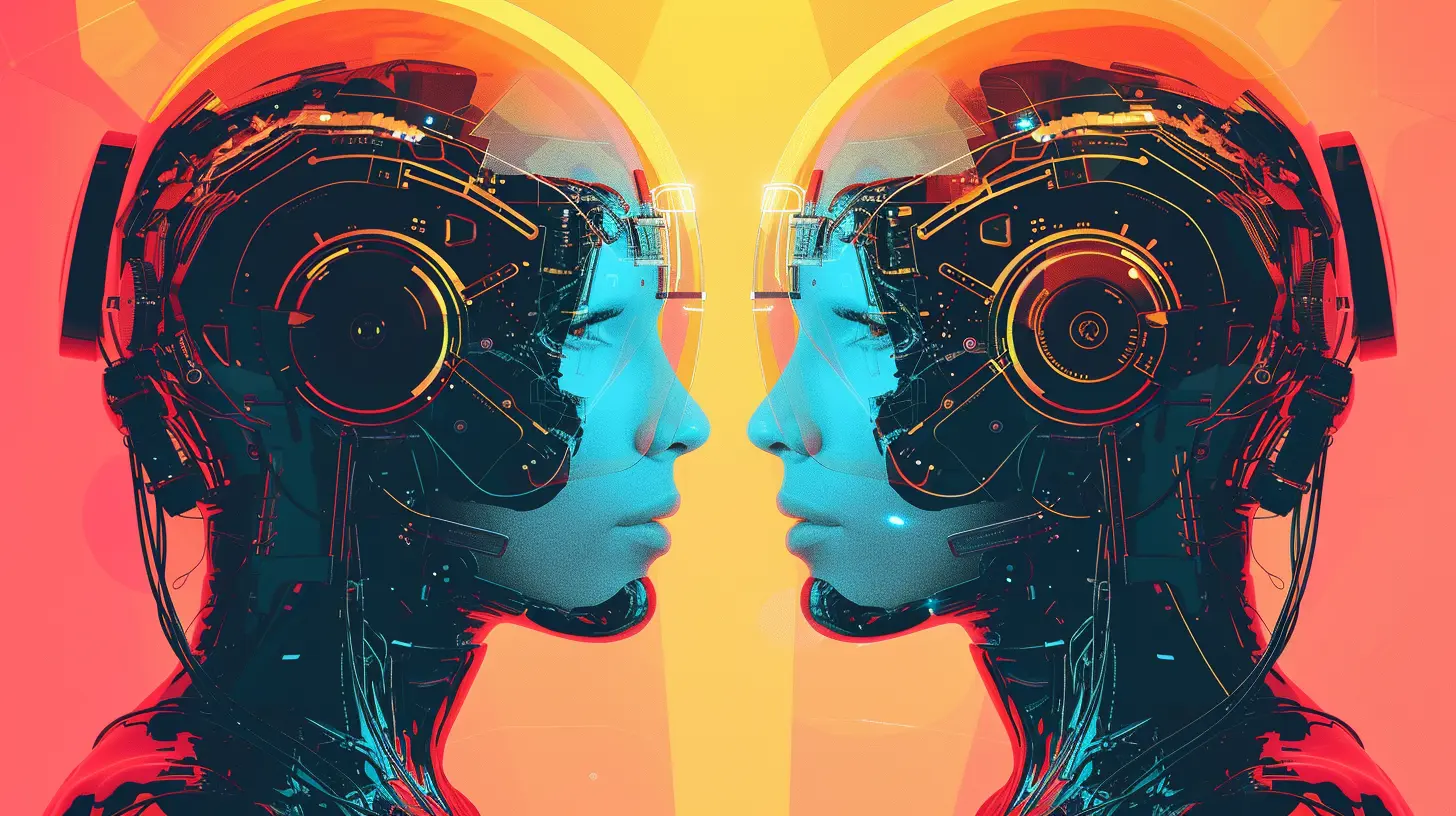How Digital Assistants are Bridging the Gap Between Humans and AI
30 September 2025
Let’s face it — we’re living through one of the most fascinating times in human history. AI is no longer just a sci-fi trope from Hollywood blockbusters. It's here. It’s real. And it’s blending into our daily lives in ways we couldn’t have imagined even a decade ago. But have you ever stopped to think about how this is happening so seamlessly?
Enter digital assistants — your Alexa, your Google Assistant, Siri, and their younger, more ambitious cousins. These digital personalities are doing way more than just telling you the weather or setting a timer. They’re the clever little translators sitting in the middle of a massive tech revolution — bridging the gap between us human beings and artificial intelligence. Sounds cool, right? But it's even deeper than that.
Let’s dive into how these digital assistants are turning science fiction into your everyday routine — and why this tech isn’t just “smart,” it’s borderline magical.
The Human-AI Gap: A Quick Reality Check
Before we get into the nitty-gritty, let’s clear the air. Humans and AI — we’re still very different. Our brains are made to feel, imagine, empathize. AI? Not so much. It's all about data, logic, patterns. So, creating a seamless interaction between these two creatures — one biological, the other computational — is no easy feat.That's where digital assistants come in. Think of them like interpreters at a United Nations conference — only instead of translating from French to English, they’re translating code and data into human-friendly conversations.
Sound simple? Not quite.
Digital Assistants: The Quiet Revolutionaries
Remember when talking to machines felt awkward? Like typing commands into MS-DOS or yelling at your printer? That’s ancient history now. Today’s digital assistants are crafted with natural language processing (NLP), machine learning, and contextual awareness baked into their DNA.They’re not just answering — they’re understanding.
Whether you're asking Siri to "text Mom I’ll be late" or telling Alexa to "play that song from Stranger Things," the assistant is decoding your intention, not just your words. That's sophisticated stuff under the hood — and it’s getting better every day.
How They Learn: Smarter With Every Interaction
Let’s talk intelligence. Real intelligence.Digital assistants aren't born smart — they're trained. Every time you speak to them, they’re learning, adapting, getting more precise. It's like raising a child that learns faster than Einstein on a caffeine binge.
They dig into your context: your preferences, your location, even the way you phrase a question. Over time, they tailor responses, predict your needs, and even suggest things before you ask. Creepy or convenient? Maybe both. But undeniably powerful.
And it all comes back to machine learning algorithms — the secret sauce that feeds on big data and spits out hyper-personalized, eerily-human reactions.
Voice: The Most Natural Interface
Here's a question: what's the most natural way for humans to communicate?It’s not typing. It’s not tapping. It’s voice.
Voice technology is the crown jewel of digital assistants. Why? Because it taps into something deeply human — our love of conversation. Unlike rigid, robotic inputs of the past, digital assistants understand speech, accents, intonation, and even sarcasm (well, sort of). The point is, you no longer have to learn how to talk to machines — the machines are learning to talk like you.
That right there? That’s the bridge.
Emotional Intelligence: Can AI Really Feel?
Okay, emotional intelligence might sound like a far stretch for AI. But hear me out.Digital assistants are getting better at recognizing the tone of our requests. Are you frustrated? Happy? In a rush? They’re picking up on these cues through voice modulation and contextual data. Some are even beginning to respond with empathy-like tones — not true emotion, but an understanding of how to react appropriately.
When a machine acknowledges your stress and speaks calmly or lightens the mood with a joke, it’s simulating human behavior. And that simulation? It’s huge in making machines feel less like cold, faceless tools and more like approachable companions.
Integration Into Daily Life: Like Air, Almost Invisible
Let’s be honest, most of us talk to our assistants without even thinking about it anymore.From smart homes to connected cars, digital assistants have slipped so smoothly into our routines, they’re basically invisible. They manage calendars, control lighting, answer trivia, suggest traffic-free routes — all while syncing across devices and apps.
It’s not just convenience. It’s immersion.
These assistants are embedding AI deeper into our daily lives, making advanced algorithms feel like second nature. That’s how the gap is being bridged — not through giant leaps, but through thousands of tiny interactions that add up to something phenomenal.
Real-Time Translation: Breaking Language Barriers
Now this is where things get a little sci-fi.Some digital assistants now offer real-time language translation. That means you could be speaking English, they’re translating it to Japanese in real time, and your friend replies in Japanese — which the assistant translates back to English.
This isn’t just cool — this is transformative. It’s breaking barriers that have separated cultures for centuries. With AI as the middleman, we’re not just talking to machines — we’re talking through them to other humans.
If that’s not bridging a gap, I don’t know what is.
From Assistance To Companionship: The Digital BFF Era
We’re inching into weird territory now — where digital assistants aren’t just helpful, they’re... companions?No, seriously. Some people talk to their assistants daily — joke with them, ask life questions, even vent. While they’re not exactly shoulder-to-cry-on material (yet), these assistants are slowly adopting traits that simulate companionship.
And this evolution hints at something fascinating — emotional human needs being met by artificial beings. It’s not just about utility anymore. It’s about relationship.
Trippy thought, right?
What’s Still Missing? The Human Touch
Let’s pump the brakes a bit.Digital assistants are impressive, no doubt. But they're not perfect. They lack genuine understanding, real emotions, and the moral judgment that often guides human decisions.
They still fumble with accents. They get context wrong. Sometimes they’ll give you a Wikipedia summary when you really just wanted to know if you can eat expired eggs.
So while the bridge is being built — it’s not quite finished. But it's under construction. And the engineers? They're doing some stunning work.
Where This Is All Heading: A Glimpse Into The Future
Imagine this: A future where your digital assistant doesn’t just respond to your needs — it anticipates them.It books your meetings before you ask. Orders your groceries because it knows you’re low on almond milk. Reschedules your gym session because it noticed you had a late night. Possibly even gives you a nudge to call your mom because, well, it’s been a while.
This isn't fantasy; it's on the horizon.
With advancements in AI, personalization, and predictive analytics, digital assistants are evolving from reactive tools to proactive partners. They’ll not only bridge the gap between us and AI — they’ll start disappearing into our lives altogether, doing more, saying less.
Final Thoughts: The Bridge That’s Making Us Better
So, how are digital assistants bridging the gap between humans and AI?By making machines approachable. By turning cold data into warm dialogue. By learning our language, our habits, our hopes. By being less tool, more teammate.
They’re not just reshaping how we interact with technology — they’re redefining what technology is.
Where does this leave us? Closer than ever to a world where human intuition and machine intelligence aren’t rivals — they’re dance partners. And digital assistants? They’re the ones playing DJ.
all images in this post were generated using AI tools
Category:
Digital AssistantsAuthor:

Adeline Taylor
Discussion
rate this article
1 comments
Ivy McCallum
Embrace digital assistants; they empower human-AI collaboration!
October 18, 2025 at 2:35 AM

Adeline Taylor
Absolutely! Digital assistants enhance our capabilities, enabling seamless collaboration and driving innovation in human-AI interactions.


